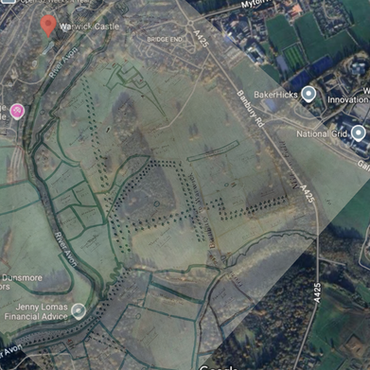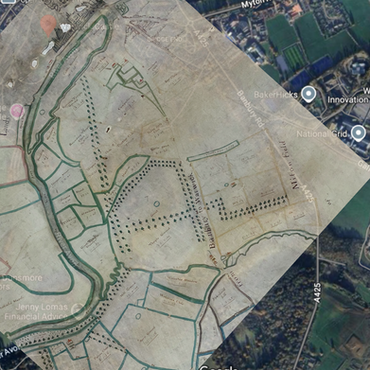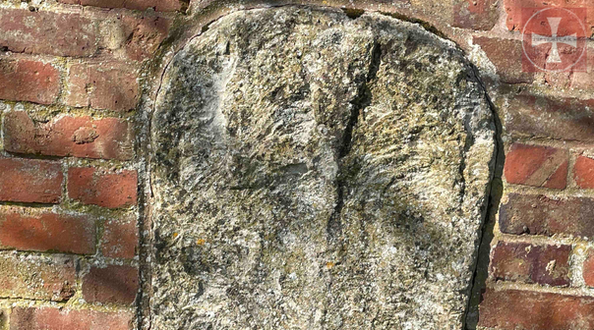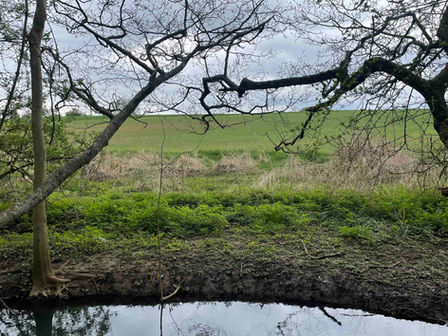

THE KNIGHTS HOSPITALLERS
IN WARWICKSHIRE
TEMPLE BALSALL
Temple Balsall: From Templar Stronghold to Hospitaller Legacy
In 1185, Roger de Mowbray granted 640 acres of land to the Knights Templar, who swiftly established a preceptory at Temple Balsall. Following the dissolution of the Templars in 1324, the estate passed to the Knights Hospitaller, who later merged it with their nearby base at Temple Grafton. By 1470, Temple Balsall was largely abandoned in favour of the more prominent Grafton site.
Despite its decline, Temple Balsall produced two notable Grand Priors of the Hospitallers: Roger Mallory in 1443 and John Langstrother in 1470.
Today, the Grand Hall of Temple Balsall still stands—now encased in red brick—as a lasting reminder of its medieval past. The Church of St Mary, originally built by the Templars and later used by the Hospitallers, also survives. Look closely, and you'll spot knightly corbels watching silently from the walls, connecting modern worshippers with centuries of sacred and military history.
TEMPLE GRAFTON
Temple Grafton: A Hospitaller Legacy—Not Templar
Despite its name, Temple Grafton was never home to the Knights Templar. The title is the result of a later clerical error—the true medieval presence here belonged to the Knights Hospitaller.
In 1189, Henry de Grafton granted land to the Hospitallers, and by 1386, they held the manor under Guy de Beauchamp, Earl of Warwick. A Hospitaller preceptory was established at Grafton by 1338, eventually becoming administratively linked to Temple Balsall.
Interestingly, historical accounts suggest the Preceptor of Balsall preferred the accommodations at Grafton, often choosing to lodge there instead. The preceptory most likely stood where Grafton Manor—now a private residence—sits today.
Nearby, a medieval dovecote still stands close to farm buildings, offering a rare and tangible connection to the Hospitaller presence that once shaped the landscape.


GRAFTON MANOR - Possible Site of the former Preceptory here.
GRAFTON Farm - Near the Manor of Grafton - Site of the Dovecote possibly Hospitallers?
TEMPLE GRAFTON - St Andrews Church
St Andrew’s Church stands at the heart of Temple Grafton,
Although the existing church building largely reflects later medieval and post-medieval development, it is believed that the Hospitallers originally maintained a smaller chapel to the west of the present site, serving the spiritual needs of the knights, brethren, and lay workers attached to the commandery.
The original medieval church in Temple Grafton was constructed by the Knights Hospitallers in the 12th century. It was a modest cruciform structure with a small weather-boarded belfry at the west end.
As the settlement grew, the chapel was likely enlarged and adapted to become the parish church we see today — a place of worship for both the religious community and the local villagers who lived and worked under the Order’s care.
The church and its associated lands provided valuable income to the Hospitallers, contributing to their wider mission. A report of 1388 records:
“Item ecclesia de Grafton in proprios usus valet per annum viij li”
— “The church of Grafton, for their own uses, is worth eight pounds a year.”
This income would have been directed towards supporting the Order’s efforts overseas, including hospitals and military campaigns in the Crusader states, as well as maintaining the commandery itself and its charitable works at home.
Adding to its rich tapestry of history, local tradition holds that William Shakespeare was married at St Andrew’s Church. While the evidence remains unproven, the story has become a cherished part of Temple Grafton’s heritage, linking the village’s medieval past with England’s greatest playwright.
Today, St Andrew’s continues to embody centuries of faith and community, its stones echoing with the prayers of knights, villagers, and poets alike.
WARWICK -
Preceptory of Knights Templars founded by Roger, Earl of Warwick, between 1123-42. It became a member of Balsall, which may have superceded Warwick as a Preceptory circa 1142. Dissolved 1308-12. In 1338, under the Knights Hospitallers, Warwick maintained a chaplain, bailiff and pensioner. Its location in Warwick Castle Park (SEE MAP BELOW) is shown on a map of 1695. Field investigations in 1968 located no traces of the feature. The Knights templars had a house beyond the bridge founded by Roger de Newbargh, and they gave the name to Temple Hill in Castle Park. There is recorded 29 servants at this location prior to 1153, 7 tradesman plus an ale-wife.
RYTON-UPON-DUNSMORE -
T
The The Valor ecclesiasticus of 1535 writes about the manor of Ryton-On-Dunsmore as below:
Ruton.—There is one messuage there, 2 carucates of land, 6 marques of Ruton. annual rent, pasture for 30 0 . bidden, and 12 acres of wood in the common. And it is let to Master Henry de la Dale, clerk of the Earl of Nil. of Lancaster, for the term of his life, paying nothing therefrom except the visitation of the Prior, when he declined there; and it was let by Brother Leonard of Tybertis
The Knights Hospitallers at Ryton-upon-Dunsmore
Ryton-upon-Dunsmore, likely established in the 11th century, was among the lands granted to Coventry Priory in 1043 by Earl Leofric. The village's name is thought to derive from the cultivation of rye in the area. By 1068, Ryton was held by a man named Alwin and home to 23 villagers, 8 smallholders, and a priest. The Domesday Book records the village as having 10 ploughlands, 8 men's plough teams, 12 acres of meadow, and a mill.
The Alwin (or Arden) family retained control of Ryton’s lands for several centuries until the 15th century, when the manor passed into the hands of the Knights Hospitallers. The Hospitallers held approximately 300 acres at Ryton-upon-Dunsmore, along with the advowson (right to appoint the priest) of the Church of St Leonard, which is believed to have stood beside the manor house and farm.
In 2017, an archaeological dig at Church Farm, adjacent to the church, uncovered evidence of the Hospitallers’ presence, shedding new light on their activities and life in the village during the medieval period.
SHERBOURNE -
The church of Sherbourne was granted to the Templars and in 1185 was valued at one mark. After the downfall of the Templars the church continued to be appropriated to the Hospitallers, their successors, until the Dissolution. The vicarage was valued at £5 in 1291 and also in 1340–1. In 1428 it was united to the rectory of Fulbrook, the church of which was demolished by 1531. The Knights Templar held 360 Acres of Land in Sherbourne, donated to them by the Roger the First Earl of Warwick Which was used for farming, and made the Manor the most valuable associated to Temple Balsall - The Site can be linked to the Templars by a Knight Templar Tithe cross (used to denote that the lands were tithe free) which is now visable as part of a modern day wall.
BARSTON
MIDDLETON -
Middleton Hall was once home to a moated manor held by the Knights Templar. The estate originally belonged to the de Marmion family, who owned the manor from 1120 to 1291. The de Marmions were prominent figures in medieval England, serving as the King's Standard Bearers and Champions—roles that included jousting in the monarch's colours and representing the Crown during coronations. During their tenure at Middleton, the de Marmions leased part of the estate to the Knights Templar in 1185. Additional land was granted to the Prior and convent of Studley in 1259. A notable architectural feature of the estate lies to the northeast of the main hall—a timber-framed structure with a projecting staircase wing. This section features an open timber roof supported by braced tie-beams and purlins.The building also includes two stone chimneys, which are attributed to the period of Templar occupation, estimated to have lasted from 1185 to around 1247.
MORTON
NEWBOLD PACEY -
The Templars held Land in Newbold Pacey amounting to 2 hides given to the Knights Templars before 1185. This passed to the Hospitallers upon their dissolution, and in 1553 the messuage and lands here belonging to the dissolved Preceptory of Balsall. Not much remains of their time here, however there are a number of earthworks and the remains of a what looks like a pond next to the Church, which could have possibly been linked to them. The Knights Hospitallers would have been gifted these lands upon the dissolution of the Templar Order.
RADFORD SEMELE -
The Templars held arable lands at Radford Semele, although there is not much documented evidence of where this was located. We do know that William Simely, allowed William Pludieu to assign lands here to the Templars at some date shortly before 1185. Geoffrey de Simely, son of William, was holding the half-fee of the Earl of Warwick in 1242 and gave to the Hospital of St. John in Warwick 2s. rent payable by Roger de Cherlecote for leave to put one end of the dam of his mill at Whitnash on Geoffrey's land in Radford. The Medieval water mill is recorded at being near what is now a new housing estate and is accessible by local road Otters Rest - see our interactive map for more information
ELDERSFIELD
FECKENHAM
NORTH PIDDLE

KNIGHT HOSPITALLER FIGURES AT WARWICKSHIRE
Warwickshire & the Hospitallers: Learn Who Shared Their Chapter of History Here
-
John Beaufitz - farmer of the Hospitallers at Balsall, and resided there
-
Henry de Buckston (Bokston) - Hospitaller Preceptor 1338
-
Robert Mallory - Hospitaller Preceptor of Balsall and Grafton - 1433
-
Thomas de Lynlee - Chaplain Grafton
-
Roger Malbry - Preceptor Balsall - 1443
-
John Langstrother - Hospitaller Preceptor 1470 - beheaded by Edward iV 1471
-
Brother Simon Dyseny, knight
-
Johannes de Sprottelee - Knight Balsall
-
Phillipus de Luda - Preceptor Grafton
-
Albinus de Nevill - Knight Grafton












